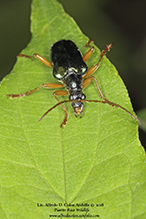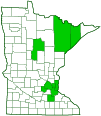cyan long-horned beetle
(Gaurotes cyanipennis)
Conservation • Description • Habitat • Ecology • Distribution • Taxonomy
Conservation Status |
|
|||||||
| IUCN Red List | not listed |
|||||||
| NatureServe | NNR - Unranked |
|||||||
| Minnesota | not listed |
|||||||
Description |
||
Cyan long-horned beetle is a common, small, flower longhorn beetle. It occurs in North America from Maine and Quebec, south to northern Georgia, and west to Minnesota, and in adjacent Canadian provinces. Adults are ⅜″ to ½″ (9 to 13 mm) long and robust.. The head is angled forward in front and abruptly constricted in back forming a neck that is visible when viewed from above. The compound eyes are black, small, and deeply notched. The antennae are slender, reddish-yellow, and long, more than half as long as the body. The base of each antenna inserted in the notch in the compound eye, but is not completely surrounded by the eye. The finger-like sensory mouth parts (maxillary palps) are segmented. The last segment is blunt or straight across at the tip. The upper thoracic shield (pronotum) is black, shiny, and bell-shaped. It is narrow at the front and wide at the base, and gradually tapered. It is not as wide as the base of the hardened wing covers (elytra), making the body appear broad-shouldered. It is inflated (arched) on top (dorsally), and has a shallow impression in the middle near the base. The angles at the rear (posterior) corners of the pronotum are rounded. The elytra are smooth; metallic blue, violet, or green; elongated; and tapered at the back. The shoulder (humeral) area of each elytra is distinctly inflated. The legs are slender and reddish-yellow. The first segment of each leg (coxa) is cone-shaped. The last part of each leg (tarsus), corresponding to the foot, is black and has five segments. The fourth segment is small and tucked between the lobes of the third, heart-shaped segment, making the tarsus appear to have only four segments. |
||
Size |
||
Total length: ⅜″ to ½″ (9 to 13 mm) |
||
Similar Species |
||
Habitat |
||
Woodlands and open areas near woodlands |
||
Ecology |
||
Season |
||
May to August |
||
Behavior |
||
Larvae feed under bark. Adults are found on flowers of trees and shrubs. They are also attracted to freshly painted surfaces, and will come to lights at night. |
||
Life Cycle |
||
|
||
Larva Food |
||
|
||
Adult Food |
||
Pollen, stamens, and nectar of the flowers of many species of trees and shrubs |
||
Distribution |
||||
|
Sources |
|||
| 6/11/2022 | ||||
Occurrence |
||||
Common |
||||
Taxonomy |
|||
Order |
Coleoptera (Beetles) | ||
Suborder |
Polyphaga (Water, Rove, Scarab, Long-horned, Leaf, and Snout Beetles) | ||
Infraorder |
Cucujiformia | ||
Superfamily |
Chrysomeloidea (longhorn and leaf beetles) | ||
Family |
Cerambycidae (longhorn beetles) | ||
Subfamily |
Lepturinae (flower longhorn beetles) | ||
Tribe |
Rhagiini | ||
Genus |
Gaurotes | ||
Synonyms |
|||
Gaurotes ione Gaurotes laportei Gaurotes leonardii Gaurotes servillei |
|||
Common Names |
|||
cyan long-horned beetle |
|||
Glossary
Elytra
The hardened or leathery forewings of beetles used to protect the fragile hindwings, which are used for flying. Singular: elytron.
Pronotum
The exoskeletal plate on the upper side of the first segment of the thorax of an insect.
Tarsus
On insects, the last two to five subdivisions of the leg, attached to the tibia; the foot. On spiders, the last segment of the leg. Plural: tarsi.
Tibia
The fourth segment of an insect leg, after the femur and before the tarsus (foot). The fifth segment of a spider leg or palp. Plural: tibiae.
visitor Photos |
|||||
Share your photo of this insect. |
|||||
| This button not working for you? Simply email us at info@MinnesotaSeasons.com. Attach one or more photos and, if you like, a caption. |
|||||
Alfredo Colon |
|||||
 |
|||||
MinnesotaSeasons.com Photos |
|||||
|
|||||

Slideshows |
||

visitor videos |
|||
Share your video of this insect. |
|||
| This button not working for you? Simply email us at info@MinnesotaSeasons.com. Attach a video, a YouTube link, or a cloud storage link. |
|||
Other videos |
|||


Created: 1/29/2019
Last Updated:

